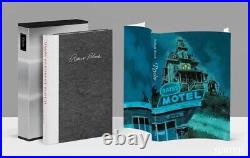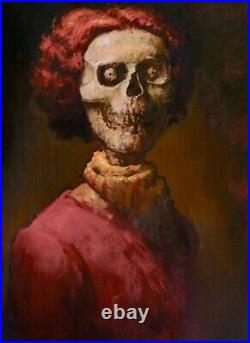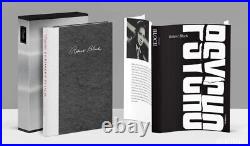





IN HAND BY 12-29-23. The Artist edition is limited to 750 copies and includes a dust jacket illustrated by Paul Mann. It is a smyth-sewn, quarter cloth binding with Zanders Elephant Hide paper covering the boards. The spine and cover are foil blocked, and the binding design is inspired by the first edition book cover. The dust jacket is double-sided featuring a licensed version, on the reverse side, of the famous first edition dust jacket originally designed by Tony Palladino. The edition is housed in a slipcase wrapped in Japanese metallic paper with cloth ends and is printed letterpress from metal type on Mohawk Superfine. This edition is signed by artists Gregg Kreutz and Paul Mann. One of the most influential horror novels of the 20th century, Psycho by Robert Bloch is the shocking story that ushered in the dawn of the slasher genre. Forty-year-old Norman Bates is a shy, overweight recluse who lives at home with his domineering mother; a mean-tempered, puritanical old woman who forbids him from having a life apart from her. Together they run the small Bates Motel in Fairvale, where business has suffered ever since the state relocated the highway. It’s the kind of place hardly anyone ever stops at anymore. As she flees town en route to her boyfriend Sam, Mary accidentally turns off of the main highway and finds herself at the Bates Motel where there are plenty of vacancies. Soon, Mary Crane will meet Norman. She will meet Mother, too. And she will grapple with the gravity of the crime she has committed as she comes to realize the cutting truth-that we all go a little mad sometimes. Originally published on April 10, 1959, The New York Times called the novel icily terrifying. The seeds Bloch planted with Psycho grew into horror staples: the serial killer, the isolated location, the butcher knife, the shower and the shocking twist ending. The voyeurism displayed in the novel created a potent combination of terror and titillation that would also become a mainstay of the genre. Throughout his opus, Bloch subtly pairs contrasting elements, fusing them into iconic imagery. The soft, matronly style of Norma and the cold steel harshness of the weapon. The old Victorian house and the neon glow of the modern motel. By pairing opposites, Bloch is constantly hinting at disassociation, toying with the reader like a cat with a mouse. The gothic and the modern. The softness and the steel. The beauty and the brutality. In 1960, Psycho was adapted into a feature film directed by Alfred Hitchcock. The director famously bought up every copy of the book he could get his hands on so that no one would know the ending, resulting in very few first editions existing today. Often ranked as one of the greatest films in cinematic history, Psycho is currently #14 on AFI’s list of the Top 100 movies, and #5 on the Top 100 All-Time Greatest Movies list by Entertainment Weekly. In 1992, the Library of Congress deemed the film “culturally, historically and aesthetically significant” and selected it for preservation in the United States National Film Registry. As Hitchcock himself stated in one of his last interviews, Psycho all came from Robert Bloch’s book.
